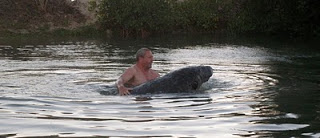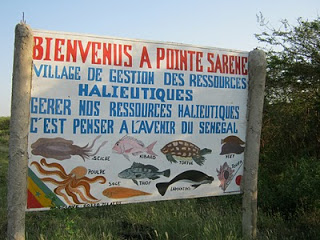Senegal: On the trail of a dead manatee
Last June an adult female manatee died in a narrow lagoon called Mbodiene. I try to follow up on all of these reports since any information we can gather adds to our sparse knowledge of the species. This manatee was particularly interesting because it had been seen alive with 2-3 others several days before it died, and photos and reports clearly indicated it was in distress. Unfortunately I was in the USA at the time and could not get to the site myself. Due to the somewhat slow chain of communication, after the manatee died no one could get to the site fast enough to collect samples before the local population butchered the carcass for meat. There were enough witnesses to verify that the manatee did die naturally, it was not killed. Several people tried to help it as it struggled to breathe. But unfortunately once it died, people couldn’t imagine seeing the meat “go to waste”.
 My guess is there was little anyone could’ve done to save it. There are no facilities in Africa to take care of injured or sick manatees (or any other marine mammals for that matter!).
My guess is there was little anyone could’ve done to save it. There are no facilities in Africa to take care of injured or sick manatees (or any other marine mammals for that matter!).
 This is the photo he gave me. By the time Karim got to the site last June, the manatee had been completely butchered and only pieces of skin were left. I will use a piece of the dried tissue for genetics. Photo courtesy of K. Sall.
This is the photo he gave me. By the time Karim got to the site last June, the manatee had been completely butchered and only pieces of skin were left. I will use a piece of the dried tissue for genetics. Photo courtesy of K. Sall.  After talking to Karim, I went out to the lagoon. I went to the site where the manatee died to collect a GPS point and see the area for myself. There were mangroves along the edge but no visible seagrasses or other aquatic plants. Although I checked at several houses, no one who had seen the manatee was around, but the site visit helps me learn about manatee use areas for the future. I’d like to find the springs and document those as well… there’s a huge network of freshwater springs that manatees use in this region.
After talking to Karim, I went out to the lagoon. I went to the site where the manatee died to collect a GPS point and see the area for myself. There were mangroves along the edge but no visible seagrasses or other aquatic plants. Although I checked at several houses, no one who had seen the manatee was around, but the site visit helps me learn about manatee use areas for the future. I’d like to find the springs and document those as well… there’s a huge network of freshwater springs that manatees use in this region.

On the way home we saw this sign for Pointe Sarene with a manatee caricature on it. Pt. Sarene also has a freshwater spring  It may seem like these little bits and pieces of information, gathered so long after the manatee died, are not much. But when we know so little, every bit helps to piece together the African manatee’s life history.
It may seem like these little bits and pieces of information, gathered so long after the manatee died, are not much. But when we know so little, every bit helps to piece together the African manatee’s life history.
